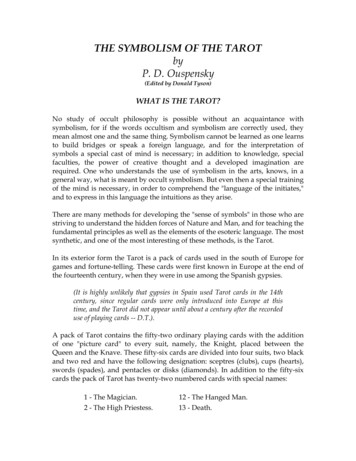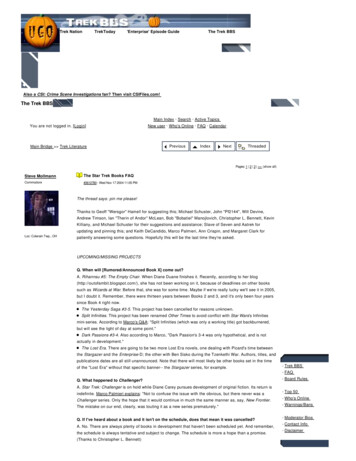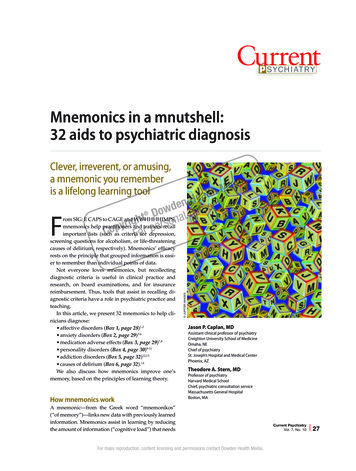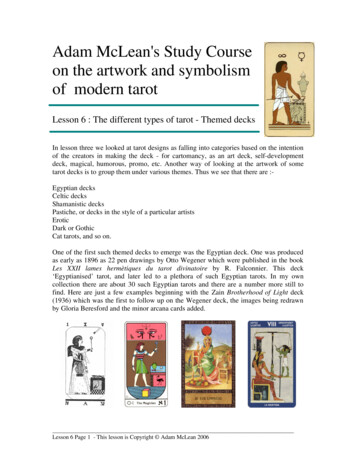
Transcription
INT-071UNITED STATES OF AMERICANUCLEAR REGULATORY COMMISSIONBEFORE THE ATOMIC SAFETY AND LICENSING BOARDIn the Matter ofCROW BUTTE RESOURCES, INC.(License Renewal for theIn Situ Leach Facility, Crawford, Nebraska)))))))Docket No. 40-8943ASLBP No. 08-867-02-OLA-BD01July 31, 2015REBUTTAL STATEMENT OF LINSEY McLEANThe following points comprise my statement:With regard to:Moreover, Dr. McLean has not established that a pathway exists by which the landapplication of treated process wastewater under dry conditions will cause thesignificant adverse impacts to human beings and wildlife that she describes (landapplication after wet weather events is not allowed under CBR’s NDEQ permit) (Ex.NRC 010 at 12). In fact, Dr. McLean identifies other pathways by which the heavymetals she discusses have been known to cause impacts to the environment, includingimpacts from uranium acting in concert with calcium ions generated by ISR mininggenerally “as well as in runoff waters of the Rocky Mountains over old uranium open pitmines” (Ex. INT-048 at 10) and “legal dumping” of arsenic “into commercial fertilizersfrom mining and ore smelting waste since 1976” (Ex. INT-048 at 14). “My Response:Application of metals in solution as ionic compounds and also as endemic organiccompounds found by other researchers in remediation of old ISL sites, that are not able tobe recovered by ion exchange, (1) (2) can be diluted ad infinitum with clean water andapplied to land with the false premise that these metals are somehow rendered less toxic,when such is not the case. It does not matter how much you dilute the metals beforeapplying the wastewater, the water portion of the solution will invariably evaporate intothe atmosphere or go deep towards the aquifers, as that is Mother Nature’s method ofrecharging aquifers for the most part, leaving the metals, which are highly ionic andPage 1 of 9
chemically “sticky” and attractive towards elements in soils because of theirelectrochemical nature, to concentrate in the surface soils over time.The inorganic forms of the metals, can be taken up by micro organisms in the soil oncethey are in solution again, at any following rain or snow, as chemical salts of all kindsbecome readily soluble again after drying and crystallization. Inevitably, there will berain or snow in amounts that would cause the metal salts to go back into solution again.Think of the drying of seawater to make table salt, and how easily that salt dissolvesagain in your soup. There are many metals salts in seawater, and they all dissolve afterdrying. By definition, chemical salts/ionic forms of metallic salts share thiscrystallization/solubility characteristic. So the fact that the wastewater is diluted adinfinitum, makes no difference in the toxicity and future hazards to wildlife and humans.It is actually a waste of clean water. In fact, over time, with the increasing buildup ofmetal salts in the soil, and the saturation of attracting elements in the soil to keep themetals in the surface soils, the dissolved metal salts could feasibly travel downward intothe groundwater below, contaminating aquifers below.Addressing the inorganic salt forms of the metals: These have been shown in numerousstudies to be able to be uptaken by micro organisms and primitive life forms andconverted to organic forms that are then able to be bioaccumulated up the food chain.Indeed, since more advanced organisms, including animals and humans lack the ability toefficiently convert inorganic minerals and metals to organic forms that are morebioavailable, Nature relies on these primitive forms of life to do that job for us. There aresterile soils at Crow Butte. The metallic waste water is not going to be applied to sterilesoil. And, as stated in my prior testimony, organic forms of metals and minerals are farmore bioavailable to living organisms than inorganic forms which have to be convertedto organics. This organification also makes the toxic heavy metals even more toxic andmore bioavailable to bioaccumulate up the food chain. Organification and increasedbioavailability and increased ability to enter into biochemical reactions in the living bodyis why we chelate/organify essential minerals in the laboratory for use in nutrition. Theseorganically chelated minerals are successfully used in humans and animals whom showinborn errors of metabolism where one or more minerals are not able to be successfullyand routinely uptaken from foods and actively carried through the gut wall, as they are ina “predigested” form. For this reason, it is not a reliable assessment of the true toxicity ofany toxic metal to evaluate and test for inorganic forms alone. Organic forms may beorders of magnitude in toxicity above an inorganic form in the living body, animal orhuman.Additionally, ruminants like deer, sheep, cows, and other animals with a biologicallyactive cecum, such as horses, have a much higher population of microorganisms in theirdigestive tracts than humans do, with our nearly extinct appendix, the evolutionarycounterpart. These animals depend on the microbiological activity of the cecum andrumen to complete their digestion, maintain immune status and provide essential aminoacids for protein needs as well as B complex vitamins and intermediary factors forhealthy biochemistry. This is how they can live in a healthy state as true vegetarians, andbe supplied all the missing amino acids not found in plants. These higher numbers ofPage 2 of 9
“probiotics” in the intestines of these animals will also convert higher levels of inorganicmetals and minerals to organification than humans, making the same levels of inorganicmetals that would be tolerable to humans, highly toxic to ruminants and cecates. Thatsame difference in toxicity is well known for nitrates in water too. So, the land areas (inand around) application of wastewater will be found, for this reason, to be more toxic forgrazing animals in the future, than simple inorganic testing [comparable to humantolerable limits] compromising the ability of the land to be reclaimed after mining stops.Further, land application during wet weather vs dry weather was deemed necessary toprevent further migration of the metals from flooding and runoff, and has nothing to dowith the actual toxic bioavailability of the metals, only the spread of their territories.(1)Arabian Journal of ChemistryVolume 4, Issue 4, October 2011, Pages 361–377(2) (Kurniawan et al., 2006).(3) Chelated Minerals in Animal NutritionRajendran, C.Kathirvelan and V.Balakrishnan, Madras Veterinary College,Chennai, INDIA(4) find references to nitrates and ruminants and organification about the rumen(5) find references to the differences in toxicity of organified heavy metals(6) Differences in Uptake of Organic vs Inorganic Forms of 48.pdf(7) How Inorganic Forms of Metals Become Organic Forms in erms.php?R 255(8) How Inorganic Forms of Metals Become Organic Forms in lications/jeq/abstracts/31/4/1146?show-t%20%20f tables&wrapper no?access 0&view article(9) Organification of Mercury by River AlgaeKate L. Buckman, Mark Marvin-DiPasquale, Vivien F. Taylor, Ann Chalmers, Hannah J.Broadley, Jennifer Agee, Brian P. Jackson, Celia Y. Chen. Influence of a chlor-alkaliSuperfund site on mercury bioaccumulation in periphyton and Low-trophic level fauna.Environmental Toxicology and Chemistry, 2015; DOI: 10.1002/etc.2964(10) The Chemistry of Selenium, Oxidation/Reduction/VolitilazationPage 3 of 9
Shows how selenium changes inorganic speciation until it volatilizes into an organic fortification(11) The Difference in Uptake in Humans of Inorganic vs. Organic Forms of Selenium toDifferent .pdfWith regard to:Q9. Ms. McLean also asserts that the liner is made of everyday plastics that areeasily degraded. Can you respond?A9. Yes. Her characterization of the pond liner is incorrect. The HDPE plastic that isused is designed specifically for use in evaporation ponds, not for use in the food andbottled water industry. Moreover, the seams in the pond liner are fusion welded and arere-welded if they are found to have failed. In December 2013, an evaluation of the linerswas performed by a third party. The liners were in satisfactory condition for continuedoperation.My Response:First: I misspoke with the term “leach" ponds. I should have said “containment” ponds ascontainment ponds were what I was describing.Second: The oxidation and degradation of the plastics in the pond liners by the lixivientsand residues in the pond water is evident in that pinhole leaks were found just 6 yrs afterinstallation. Pinhole leaks are classic for what you would expect to find in plasticsdegradation by oxidizing chemicals. The plastics used in pond liners are thicker, true,however still made of the same kind of plastic that is referred to in my testimony, HDPE,commonly used in industries of all kinds, including food industry and easily degraded,which is why it is so easy to recycle. The thickest geomembrane available is 80 milHDPE resin designed specifically for flexible geomembrane applications and containsapproximately 97.5% polyethylene, 2.5% carbon black and trace amounts of antioxidantsand heat stabilizers; no other additives, fillers or extenders are used. This is the exactsame chemical recipe that all HDPE products are made from, with exception of colorants.The only difference between all HDPE products is the thickness. Some geomembranescontain a dacron fabric inside of the applied plastics for better protection against tears andmechanical breaks, however the same HDPE plastic coats the fabric layer, subjected tothe same chemical degradation fate, and that plastic is the sole protection from leaks. Theinterior fabric by itself is not leakproof. So there is nothing special about the pond linersthat is inherently different from the common milk jugs.Page 4 of 9
The geomembranes typically come in 22.5 ft wide rolls, so there has to be several stripsdown the entire length of the ponds of fusion between strips, capable of forming leaks,since that fusion is done under the less than ideal “field conditions” and not at the factoryin pdf?t 1438130708147shows 28 day exposures to the best pond liner of different chemicalsThe record speaks for itself:August 12, 1997: Discovery of Pinhole Leaks in Upper Liner of Process WaterEvaporation Pond - this demonstrates the exact type of degradation you wouldexpect from chemical exposure, and just 6 yrs after initial useMay 14, 2004: Leak detected at Pond 1May 5, 2006: Leak detected at Pond 4June 5, 2009: Evaporation Pond 1 liner leak detectedJune 18, 2009: Evaporation Pond 4 liner leak detectedDec. 31, 2009: Evaporation Pond 4 Liner LeakJune 11, 2010: Evaporation Pond 3 liner leak detectedJune 1, 2011: Evaporation Pond 1 liner leakThree of 4 ponds have been found to leak.With regard to:Mr. Teahon acknowledges Ms. McLean’s discussion of potential impacts from seleniumcontamination, but notes that she provides no site-specific assessment of the impacts ofhypothetical land application of wastewater at Crow Butte. Her generalized assertionsprovide no site-specific reason to question the conclusions of the LRA or EA regardingland application of wastewater. She does not acknowledge that Crow Butte has notperformed land application at the site or that Crow Butte has no plans to conduct landapplication. She also does not account for the limitations on Crow Butte’s use of landapplication for wastewater — imposed by bothMy Response:Page 5 of 9
The potential impacts for Crow Butte for selenium contamination are the same as havebeen recognized at all other ISL sites, when continuous application of even dilutedwastewater are land applied. The water portion of the mix evaporates or goes down in thesoils, leaving the electrostatic heavy metals, including selenium, to increase over time inthe upper soils. I refer to the first response in this document regarding the dilution factorof wastewater, the ineffectiveness of such and wasting of clean water in the unnecessarydilution process.With regard to:Mr. Teahon also explains that, although outside the scope of the admitted contention, Ms.McLean provides testimony on evaporation ponds. Mr. Teahon then describes the design,operation, and decommissioning requirements for evaporation ponds at Crow Butte. Hediscusses the requirement to maintain a minimum “freeboard” to accommodate rainevents, as well as the obligation to keep the sediments in the pond.My Response:Crow Butte has not included a description for their active air application of the liquidwaste from the ponds. The ponds are supposed to be, by NRC description, strictly “solar”evaporation ponds. Aerosol sprayers can be clearly observed from both the ground andalso satellite pictures provided by Google Maps. The technique seems to place a row of11 aerosol sprayers in a line down the middle of the ponds. In fact, the satellite picturesclearly show the spray picked up and carried by the wind from those sprinklers.fig.1fig.2Page 6 of 9
fig.3I am concerned that these aerosol sprayers are putting even more radiation and metalsinto the air to be spread by the wind, and this would also qualify as an air and/or landapplication of sorts. I have not found anywhere in NRC documents, the permit for an airapplication.With regard to:A.12.3 (N. Goodman) Dr. McLean makes several claims regarding the impacts ofselenium and other heavy metals on human health and wildlife. She states at times thatthese health impacts result from “low levels” of selenium and other heavy metals in theorganism (Ex. INT-048 at 9, 15, 18, 19, 22), and at other times from “high levels” ofthese metals (Ex. INT-048 at 8, 9, 12, 14, 15, 19-20, 24), where levels are discussed atall. However, she does not address with any specificity the concentration of selenium thatmust be present in the land-applied treated process wastewater at the Crow Butte site tobe expected to cause the impacts she describes.My Response:The actual toxicity and respective levels for toxicity of individual heavy metals includingselenium will be dependent upon the chemical forms in which these metals exist. I haveexplained in depth, and shown by slides included, that different chemical forms of metalsand minerals have different levels of toxicity in the living body and different destinationsin the living body too. Bioaccumulation of organified metals that we know does exist as aPage 7 of 9
result of bacteria and algae upon the metals, has been demonstrated to occur. Theorganified metals are considerably more toxic than inorganic forms, so lower levels ofthese forms will show toxic manifestations. Speciation testing would be necessary toproperly assess toxicity of the inorganic forms, and these numbers are typically notreleased to the public by mining companies. In fact, in researching ISL site testing, Icould not find even one copy of such testing. I called the testing labs and spoke with twobench chemists from two different labs, they both told me that they could not release tome or publish any testing results, and that the reason that the numbers were not releasedby their clients is because those numbers were so characteristically bad that miningcompanies chose not to release them. So, to properly asses true toxicity to the livingbody, we would have to have speciation of inorganic metal compounds as well as anassessment of organic forms. These tests are not being done. Only very limited andsporadic speciation is done and then only for arsenic and selenium, when the other heavymetals are also active in toxicity, and also synergistic in their toxicity. The limitedspeciation testing of infrequent arsenic and selenium, without the other metals, and notpublished, is inadequate in assessing true potential toxicity. There is a side synergistictoxicity of the metals in that they oppose and interfere with nutritional metals asdemonstrated by the mineral wheel slides, that is independent of the toxicity from thebiochemical effects in biochemical pathways of the chemical forms, and this must also beconsidered in total toxicity. In closing on this subject, the toxicity of the actual levels ofmetals cannot be determined until proper testing is done. In place of this lack of testing,we can follow the toxicity by following the health consequences of populations livingdownstream of the source of contamination, where local wells are recharged by the WhiteRiver which runs through/close to the site. Currently, and still in process, there is acanvassing of door to door communities in Crawford, Pine Ridge and Rosebud of ahealth survey that will compare statistical analyses of those living with wells that are inthe recharge area of the White River, those who are on web water piped in from theMissouri River and not contaminated, and those who are on well water not in therecharge zone of the White River. Following that survey, there will be water chemistrystudies done on these groups as well as hair mineral analysis to show uptake andexposure of 39 metals and minerals in the human and animal populations.Pursuant to 10 C.F.R. § 22.304(d) and 28 U.S.C. § 1746, I declare, under penalty ofperjury, that the foregoing is true and correct to the best of my knowledge and belief.Dated this 31st day of July, 2015.Respectfully submitted,Page 8 of 9
Linsey McLeanPage 9 of 9
soil. And, as stated in my prior testimony, organic forms of metals and minerals are far more bioavailable to living organisms than inorganic forms which have to be converted to organics. This organification also makes the toxic heavy metals even more toxic
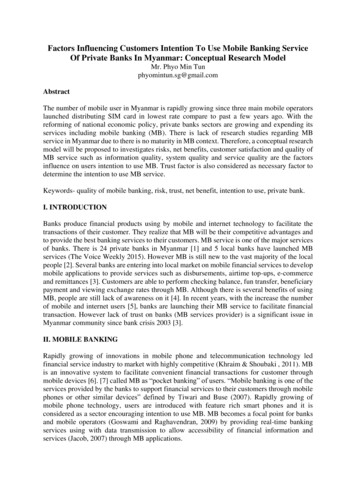
![IN THE SUPREME COURT OF T]-lE STATE OF MONTANA](/img/7/526b198c923f8.jpg)





